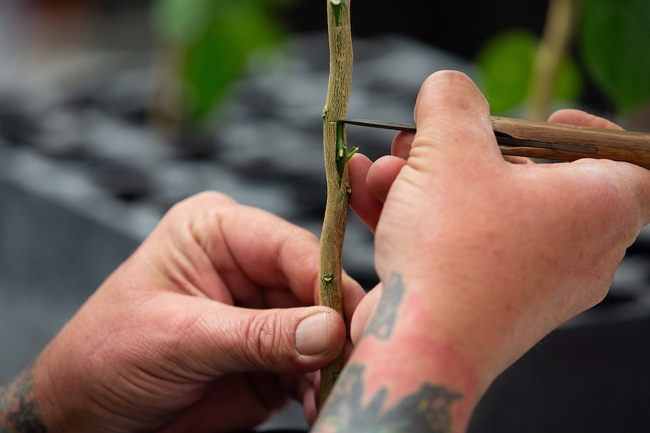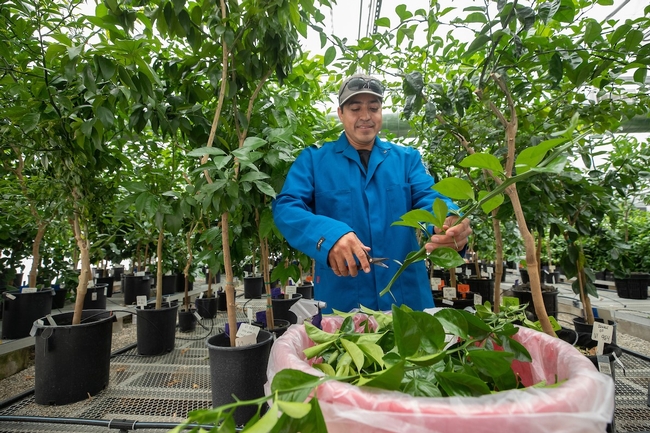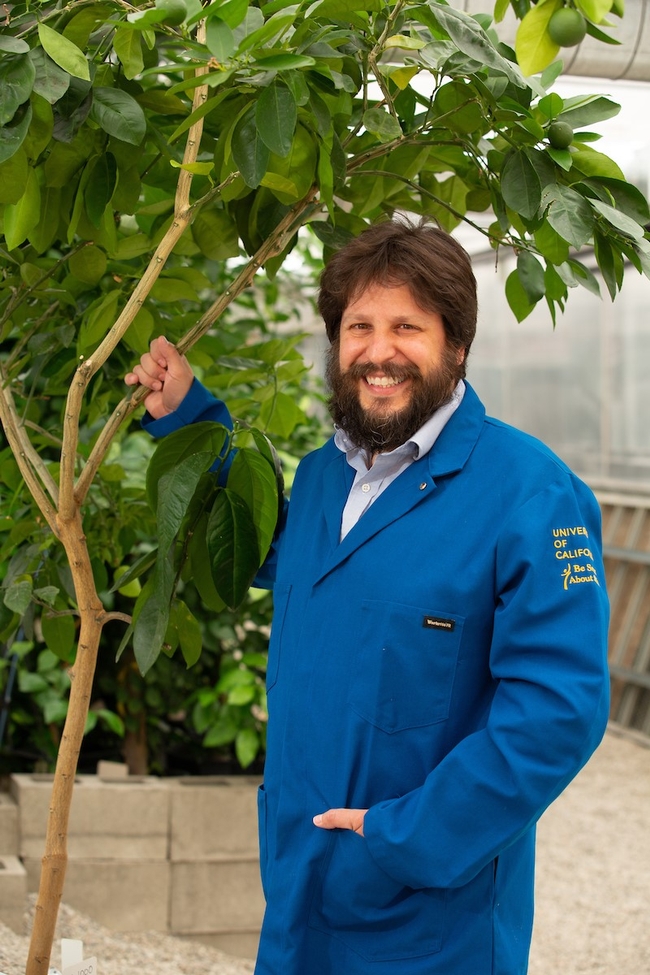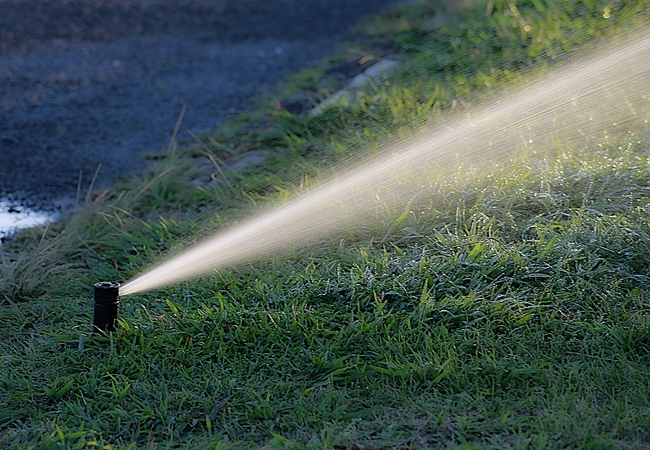
Posts Tagged: protection
You, too, can grow California’s oldest living orange variety
Sweet Mother Orange Tree released from quarantine
The 1000th tree okayed for growing by California's Citrus Clonal Protection Program happens to be the oldest living orange variety in the state.
The program, housed at UC Riverside, is the first of its kind in the world. It began in the 1950s, and its scientists spend up to three years testing and clearing citrus trees of disease so they can be released to commercial and private growers.
By law, every citrus tree newly propagated in California can be traced back to one mother tree created at UCR through the protection program. Program Director Georgios Vidalakis and his group begin their process by testing incoming trees for more than 30 citrus diseases, whether the diseases are known to have emerged in the state or not.
The treatment for any disease identified in that first round of testing is to make a new mini tree from a few cells of the original budwood — short, leafless twigs with buds meant for propagation. “We use special plant cells for this process that diseases cannot penetrate,” Vidalakis said.
After the mini tree grows large enough, program scientists go back and do a second round of testing for disease, making sure they picked the right cells for propagation and eliminating any prior trace of illness.
If it passes the arduous second set of tests, the new tree gets a variety index or VI number that accompanies it for the rest of its life, and it is released to the public.
Dubbed the Mother Orange Tree, Bidwell's Bar is a sweet Mediterranean orange brought to California from Mazatlán, Mexico, and planted in 1856. It was first planted near the Bidwell Bar Bridge near Oroville, then dug up and replanted twice.
Its survival skills are some of the reasons Tom Delfino, former California Citrus Nursery Society director, recommended the old orange tree for the protection program.
“Apparently this variety is very rugged,” Delfino said. “Not only has it survived a lot of cold Northern California winters, but the tree has been dug up and replanted twice — once to protect it from impending flood, and again to make way for the Oroville Dam.”
Much of the state's orange industry is based in areas with warm weather. Delfino, who lives in the San Francisco Bay Area, finds citrus an exciting challenge to grow. By suggesting Bidwell's Bar for approval, he was hoping the protection program would clear it so he could buy its budwood.
On the occasions he has visited the original tree, Delfino said the fruit in reaching distance was always gone. “I think it must be tasty because locals grab it for themselves,” he said. “Makes me even more eager to grow and eat my own. I'm extremely pleased the VI testing is completed so I can acquire it.”

Delfino also hopes that this variety will catch on with commercial growers.
“My thought is our citrus industry is concentrated in the southeastern San Joaquin Valley and is subject to a number of pests that like the warm climate there,” Delfino said. “Though this has seeds, which may be a deterrent, it can be grown in colder areas that discourage some of those insects.”
The tree arrived in California nearly two decades before the better-known Washington Navel orange grown by Eliza Tibbets in Riverside. The navel is named for a structure at the bottom end of the fruit, which resembles a belly button. This structure is actually a separate fruit inside the larger fruit. The Washington Navel is also seedless, contributing to its popularity.
“Bidwell's Bar is an example of what was grown in California before the Washington Navel came to dominate, and now that it has a VI number, others can grow it too,” said Tracy Kahn, curator of the Givaudan Citrus Variety Collection at UCR.
Kahn says it's important to preserve the genetic material from a tree with such significance to California. “Some people were worried it was going to die, but now we have an officially cleared source of this historic tree, and it is protected for future generations,” Kahn said.
UC Master Gardeners ‘Garden Walks’ conserves millions of gallons of water annually in Marin
The Marin Municipal Water District has saved nearly 30 million gallons of water since it initiated a partnership with UC Cooperative Extension's Master Gardener program in Marin to teach residents how to conserve water.
The program, Garden Walks, was established in 2008 to help Marin conserve water in a district with limited supply. MMWD purchases about 75% of its water from reservoirs on Mt. Tamalpais and in west Marin, and the rest from Sonoma County's Russian River water system.
Garden Walks provides personalized information and advice to water district customers focused on improving their irrigation practices to conserve water. The part-time coordinator sets up about 150 appointments a year for UC Master Gardener volunteers to visit the homes of Marin County residents and teach them how to manage their outdoor water usage with conservation in mind.
“When we finish our visits, I hope that the client is more confident about being proactive in their garden,” said Pam Polite Fisco, the program coordinator. “We hope they will be saving water, will use natives and will encourage wildlife in their gardens.”
The volunteers, dispatched in pairs, spend about an hour at the homes. They walk the garden and talk with residents about grouping plants with similar water requirements, adding mulch to the soil surface and composting clippings, leaves and other green waste so it stays on the property.
The UC Master Gardeners teach the residents how to check their water meters and use the meter to help determine whether there are leaks in the system. They provide advice on water-conserving plants, such as natives or other drought-tolerant plants. They ask the residents to run their sprinklers and other irrigation systems to ensure they know how to manage the controls.
The majority of the water savings realized by the program stems from repairing leaks and cutting back on overwatering, said Steven Swain, UC Cooperative Extension horticulture advisor and the technical advisor to the Marin County Master Gardener program.
As part of their agreement with UC Cooperative Extension, the Marin Water District monitors changes in water usage and reports them annually on their website, allowing Swain to determine the program's impact.
The majority of water savings during the life of the program is attributable to just one quarter of the houses Master Gardeners visited; three quarters of participants were managing water sustainably.
“Sometimes, our volunteers just give the residents a pat on the back and compliment them for a job well done,” Swain said.
About 6% of the clients visited have hidden water leaks in their irrigation systems. These leaks can waste huge amounts of water if not caught, and account for a large portion of the water savings. Another 18% of clients are overwatering, which accounts for much of the rest of the savings.
Considering the value of the water conserved by the Garden Walks program, the $40,000 annual cost to hire the coordinator is more than offset by the reducing amount of water the district must provide.
This program has received a number of awards, including the Marin Conservation League's Ted Wellman Water Award in 2010. In 2011, it received first place in the UC Master Gardener's Search For Excellence awards and the Community Outreach Award at the National Extension Master Gardener Coordinating Conference. Marin County residents have also praised the program.
“The Master Gardener team was friendly, professional and helpful and shared their positive attitude to their garden and their outreach,” said Fairfax resident ‘Julie' in a follow-up survey
‘Jean' of San Rafael said, “I'm a beginning gardener. They helped me figure out how to start off right.”
A number of California counties were inspired by the success of the Marin County Garden Walks program and have adopted similar efforts to visit homeowners and assess irrigation efficiency.
View a video about the Marin Garden Walks porgram:
What is a pesticide?
When you hear the term “pesticide,” what comes to mind? Do you understand what...
Amazon Fined for Selling Illegal Pesticides
Online marketplace Amazon.com was recently fined $1.2 million by the United States Environmental...
Impact of Controlling Yellow Starthistle on Watershed Runoff and Groundwater Levels
Yellow starthistle (Centaurea solstitialis) (YST) is the most pervasive invasive and noxious weed...



